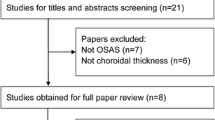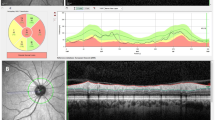Abstract
Purpose
The assessment of the retina and choroid of patients with chronic rhinosinusitis (CRS), via spectral domain-optical coherence tomography (SD-OCT), was aimed in this study. We proposed that chronic upper airway restriction caused by chronic sinusitis could deteriorate the retinal and choroid morphology.
Methods
This prospective controlled study included a total of 90 eyes of 90 patients, 30 of whom were CRS with nasal polyposis (CRSwNP), 30 of whom were CRS without nasal polyposis (CRSsNP) and 30 of whom were healthy controls (HC). Only the right eye of the patients were evaluated. All patients underwent full otorhinolaryngologic and ophthalmologic examinations, including SD-OCT.
Results
Average retinal nerve fiber layer (RNFL) and RNFL in superior and inferior quadrants were measured significantly lower in CRS patients compared to HC. Ganglion cell-inner plexiform layer (GCIPL) thickness in all sectors was thinner in patients with CRS than in HC with significantly lower values in all sectors except inferior. Mean average GCIPL thickness and GCIPL thickness in the inferior sector were significantly lower in CRSwNP than CRSsNP patients.
Conclusion
CRS may lead to thinning in the choroidal thickness, RNFL thickness, especially in the superior and inferior quadrants and GCIPL thickness, presumably related with hypoxia, endothelial dysfunction, inflammation and vascular dysregulation. Ocular manifestations of the CRS should be taken in the consideration during the management of this disease.
Similar content being viewed by others
Availability of data and material (data transparency)
All data are stored in institutional software.
References
Blackwell DL, Lucas JW, Clarke TC (2014) Summary health statistics for U.S. adults: national health interview survey, 2012. Vital Health Stat 10:1–171
Dennis SK, Lam K, Luong A (2016) A review of classification schemes for chronic rhinosinusitis with nasal polyposis endotypes. Laryngoscope Investig Otolaryngol 1(5):130–134
Stevens WW, Peters AT, Hirsch AG et al (2017) Clinical characteristics of patients with chronic rhinosinusitis with nasal polyps, asthma, and aspirin-exacerbated respiratory disease. J Allergy Clin Immunol Pract 5(4):1061–1070
Hens G, Vanaudenaerde BM, Bullens DM et al (2008) Sinonasal pathology in nonallergic asthma and COPD:-united airway disease- beyond the scope of allergy. Allergy 63:261–267
Özdemir R, Yorulmaz A, Kutlu R et al (1999) Loss of nocturnal decline of blood pressure in patients with nasal polyposis. Blood Press 8(3):165–171
Entezari M, Karimi S, Ramezani A, et al. Choroidal thickness in healthy subjects. J Ophthalmic Vis Res. 2018 Jan-Mar;13(1):39–43. https://doi.org/10.4103/jovr.jovr_148_16. PMID: 29403588; PMCID: PMC5782455.
Ugurlu E, Pekel G, Altinisik G et al (2018) New aspect for systemic effects of COPD: eye findings. Clin Respir J 12:247–252
Ozge G, Dogan D, Koylu MT et al (2016) Retina nerve fiber layer and choroidal thickness changes in obstructive sleep apnea syndrome. Postgrad Med 128(3):317–322
Cinici E, Tatar A (2015) Thickness alterations of retinal nerve fiber layer in children with sleep-disordered breathing due to adenotonsillar hypertrophy. Int J Pediatr Otorhinolaryngol 79(8):1218–1223
Fokkens WJ, Lund VJ, Mullol J et al (2012) EPOS 2012: European position paper on rhinosinusitis and nasal polyps 2012. A summary for otorhinolaryngologists. Rhinology 50:1–12
Chung SD, Chen PY, Lin HC, Hung SH (2014) Comorbidity profile of chronic rhinosinusitis: a population-based study. Laryngoscope 124:1536–1541
Orb Q, Pulsipher A, Smith KA et al (2019) Correlation between systemic inflammatory response and quality of life in patients with chronic rhinosinusitis. Int Forum Allergy Rhinol 9(5):458–465
Matsumoto K, Kawayama T, Kinoshita T et al (2015) Chronic rhinosinusitis is associated with airflow obstruction in japanese never-smokers without asthma. Int J Respir Pulm Med 2:023
McGowan FX Jr (1992) Cardiovascular and airway interactions. Int Anesthesiol Clin 30(21–44):14
Lee WH, Kim JW, Lim JS et al (2018) Chronic rhinosinusitis increases the risk of hemorrhagic and ischemic stroke: A longitudinal follow-up study using a national sample cohort. PLoS ONE 13(3):e0193886
Lieu JE, Feinstein AR (2000) Confirmations and surprises in the association of tobacco use with sinusitis. Arch Otolaryngol Head Neck Surg 126:940–946
Unsal AIA, Basal Y, Birincioglu S et al (2018) Ophthalmic adverse effects of nasal decongestants on an experimental rat model. Arquivos Brasileiros de Oftalmologia 81(1):53–58
Garg A, Das-Bhaumik R, Nesbitt AD et al (2010) Visual loss secondary to eosinophilic mucin rhinosinusitis in a woman: a case report. J Med Case Reports 4(1):350
Kurimoto T, Tonari M, Ishizaki N et al (2011) A case of eosinophilic chronic rhinosinusitis associated with optic neuropathy. Clin Ophthalmol 5:853–856
Ikeda M, Iwahashi C, Hirai T et al (2019) A case of eosinophilic chronic rhinosinusitis associated with choroidal folds and ocular motility disorder. Case Rep Ophthalmol 10:89–94
Wang W, He M, Huang W (2017) Changes of retinal nerve fiber layer thickness in obstructive sleep apnea syndrome: a systematic review and meta-analysis. Curr Eye Res 42(5):796–802
Chen WC, Chang YT, Chen SF et al (2018) The symptom burden of autonomic dysfunction is positively associated with chronic rhinosinusitis status. Rhinology 56(3):227–233
Hayreh SS (2001) The blood supply of the optic nerve head and the evaluation of it - myth and reality. Prog Retin Eye Res 20(5):563–593
Tan KA, Gupta P, Agarwal A et al (2016) State of science: Choroidal thickness and systemic health. Surv Ophthalmol 61(5):566–581
Dinh-Xuan AT, Higenbottam TW, Clelland CA et al (1991) Impairment of endothelium-dependent pulmonary-artery relaxation in chronic obstructive lung disease. N Engl J Med 324(22):1539–1547
Elcioglu OC, Afsar B, Bakan A et al (2016) Chronic rhinosinusitis, endothelial dysfunction, and atherosclerosis. Am J Rhinol Allergy 30(3):e58–e61
Oyer SL, Nagel W, Mulligan JK (2013) Differential expression of adhesion molecules by sinonasal fibroblasts among control and chronic rhinosinusitis patients. Am J Rhinol Allergy 27(5):381–386
Altinkaynak H, Kara N, Sayın N et al (2014) Subfoveal choroidal thickness in patients with chronic heart failure analyzed by spectral-domain optical coherence tomography. Curr Eye Res 39(11):1123–1128
He M, Han X, Wu H et al (2016) Choroidal thickness changes in obstructive sleep apnea syndrome: a systematic review and meta-analysis. Sleep Breath 20:369–378
Marin JM, Carrizo SJ, Vicente E, Agusti AG (2005) Long-term cardiovascular outcomes in men with obstructive sleep apnoea-hypopnoea with or without treatment with continuous positive airway pressure: an observational study. Lancet 365:1046–1053
Kocamış Ö, Zorlu D (2018) Choroid and retinal nerve fiber layer thickness in patients with chronic obstructive pulmonary disease exacerbation. J Ophthalmol 2018:1201976
Funding
This research was not supported financially.
Author information
Authors and Affiliations
Corresponding author
Ethics declarations
Conflict of interest
Authors declare that there is no conflict of interest.
Additional information
Publisher's Note
Springer Nature remains neutral with regard to jurisdictional claims in published maps and institutional affiliations.
Rights and permissions
About this article
Cite this article
Karakahya, R.H., Korkmaz, M. & Korkmaz, H. Decreased retinal nerve fiber and choroidal thickness in chronic rhinosinusitis. Eur Arch Otorhinolaryngol 278, 2863–2868 (2021). https://doi.org/10.1007/s00405-020-06552-0
Received:
Accepted:
Published:
Issue Date:
DOI: https://doi.org/10.1007/s00405-020-06552-0




